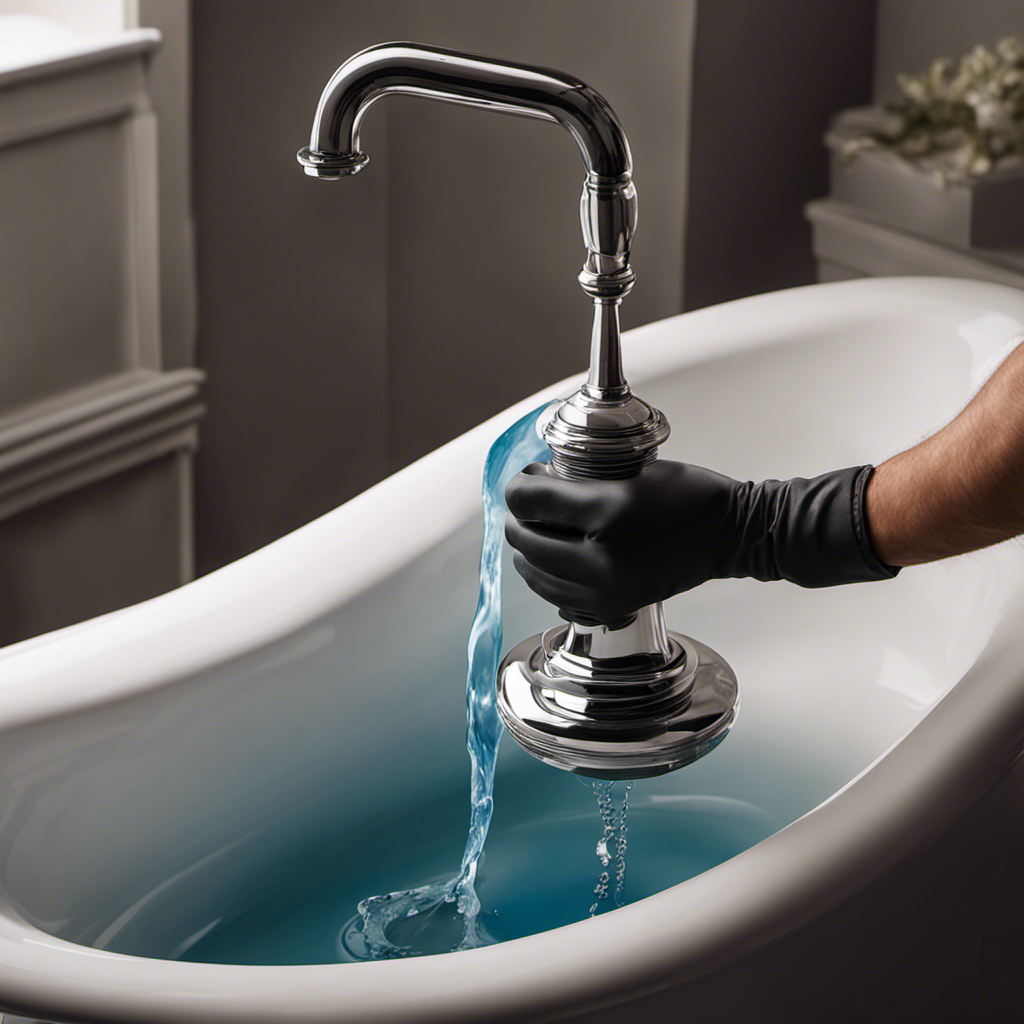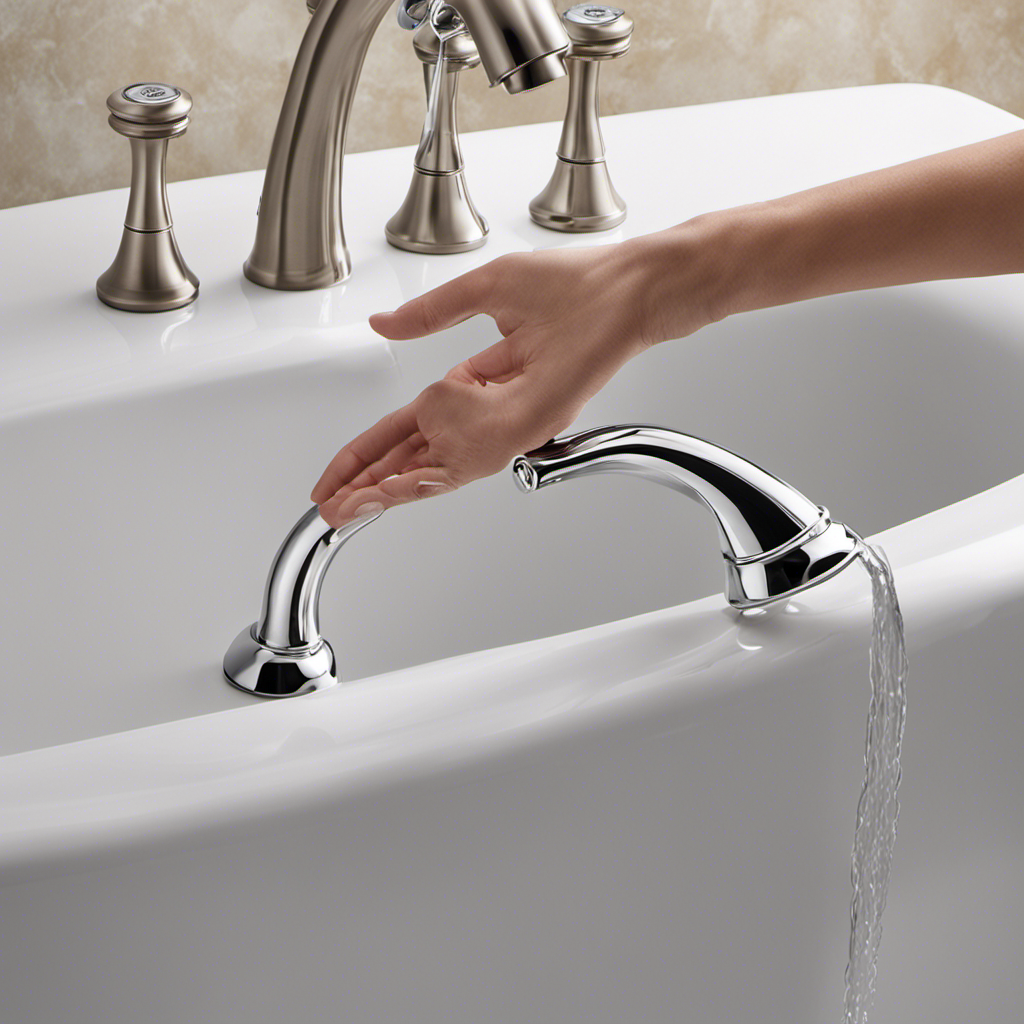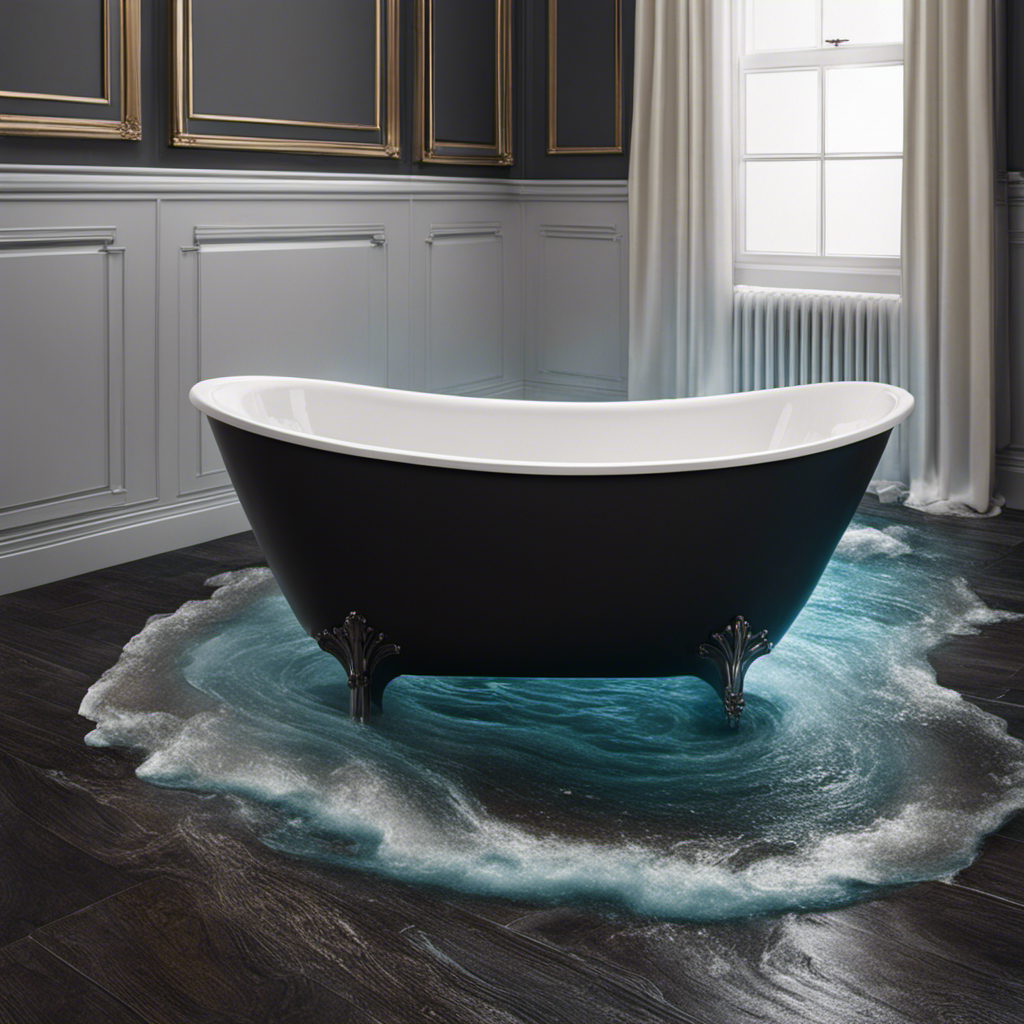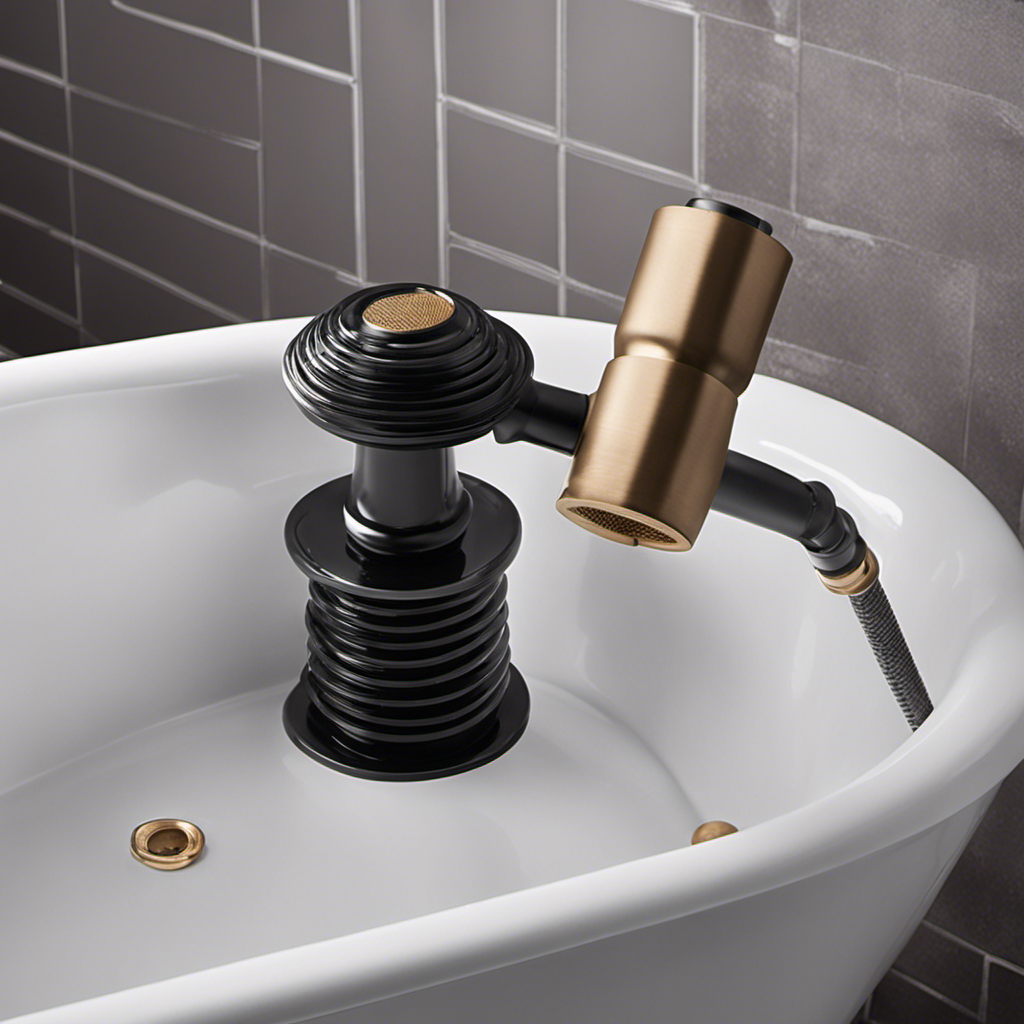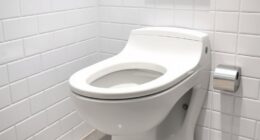Imagine your bathtub drain as a stubborn traffic jam, causing frustration and inconvenience. But fear not, because I am here to guide you through the process of unclogging your bathtub drain effortlessly.
In this article, I will provide you with step-by-step instructions, using simple tools and natural remedies, to restore the smooth flow of water in your tub.
So, put on your DIY hat and let’s tackle this drain clog together!
Key Takeaways
- Buildup of hair and soap residue is a common cause of bathtub drain clogs.
- Using hair catchers or drain strainers can help prevent clogs.
- Regular cleaning with a plumber’s snake or plunger is necessary to remove clogs.
- It is important to exercise caution when using chemical drain cleaners and consider alternative methods like baking soda and vinegar.
Common Causes of Bathtub Drain Clogs
One of the most common causes of bathtub drain clogs is a buildup of hair and soap residue. Hair can easily get caught in the drain, especially if you have long hair or if multiple people use the bathtub. Over time, this hair combines with soap residue and other debris, creating a stubborn clog that prevents water from draining properly.
To prevent hair clogs, a simple solution is to use a drain strainer or hair catcher. These inexpensive devices fit over the drain and catch hair before it has a chance to go down the drain.
Another option is to regularly clean the drain using a plumber’s snake or a plunger. If you’re dealing with a stubborn clog, chemical drain cleaners can be effective, but they should be used with caution and according to the manufacturer’s instructions.
Tools and Supplies You’ll Need
To tackle this task, you’ll need a plunger and a drain snake. These tools are essential for unclogging a bathtub drain effectively.
The plunger creates suction, which helps to dislodge the clog by pushing and pulling on the blockage. When using the plunger, ensure that you cover the overflow drain with a wet cloth to create a tight seal.
Alternatively, you can use a drain snake, which is a flexible tool that can reach deep into the drain and break up the clog. Insert the snake into the drain and rotate it while pushing it in and out. This will help to break up the clog and clear the drain.
These methods are effective for most clogs, but if you’re looking for alternative methods, consider using baking soda and vinegar or a chemical drain cleaner. However, be cautious when using chemicals and follow the manufacturer’s instructions carefully.
Step-by-Step Guide to Unclogging a Bathtub Drain
Clogged drains can be a common and frustrating issue in any home, but understanding the common causes of clogs can help prevent them from occurring in the first place.
When it comes to unclogging a bathtub drain, having the right tools is essential. From plungers to drain snakes, there are various options available to effectively remove clogs.
Additionally, implementing preventive measures such as regular drain cleaning and avoiding the disposal of certain items can help keep your bathtub drain clear and functioning properly.
Common Clog Causes
When you have a bathtub drain clog, one common cause could be hair and soap residue buildup. Hair tends to get caught in the drain, leading to blockages over time. Additionally, soap scum can accumulate and harden, further contributing to the clog.
To prevent hair clogs, it’s recommended to use a drain cover or strainer that catches hair before it goes down the drain. Regularly cleaning the drain cover and removing any trapped hair can also help prevent clogs.
As for removing soap scum, a mixture of baking soda and vinegar can be an effective solution. Pour the mixture down the drain, let it sit for a while, and then flush it with hot water. This will help break down the soap scum and clear the drain.
Tools for Unclogging
Using a plunger is a common tool for clearing clogs in drains. However, there are other tools and solutions that can be used to effectively unclog a bathtub drain. Here are some options to consider:
| Tool | Description |
|---|---|
| Drain Snake | A long, flexible wire that can be inserted into the drain to break up and remove clogs. |
| Zip-It Tool | A plastic tool with barbs that can be inserted into the drain to pull out hair and debris. |
| Wet/Dry Vacuum | Can be used to create suction and remove clogs from the drain. |
| Power Tools | High-powered tools, such as a drain auger or drill, can be used to break up stubborn clogs. |
| Chemical Solutions | Chemical drain cleaners can be poured into the drain to dissolve and remove clogs. However, they should be used with caution and according to the manufacturer’s instructions. |
Remember to always follow safety guidelines when using power tools and chemical solutions. If you’re unsure or uncomfortable with attempting to unclog the drain yourself, it’s best to consult a professional plumber.
Prevention Tips for Clogs
To prevent clogs in your bathtub drain, it’s important to take preventative measures such as using a drain cover and regularly cleaning the drain. Hair is one of the main culprits when it comes to clogging drains, so using a drain cover is essential. These covers have small holes that catch hair and prevent it from going down the drain.
Cleaning the drain regularly is also important to remove any hair or debris that may have accumulated. You can use a drain snake or a plunger to remove any clogs that have already formed.
In the next section, we will explore natural home remedies for unclogging a bathtub drain, which can be used as an alternative to chemical-based drain cleaners.
Natural Home Remedies for Unclogging a Bathtub Drain
When it comes to unclogging a bathtub drain, there are several natural home remedies that can be effective.
One popular method is using a combination of vinegar and baking soda. Simply pour half a cup of baking soda down the drain, followed by half a cup of vinegar, and let it sit for about 30 minutes before rinsing with hot water.
Another method is the boiling water technique, where you carefully pour boiling water down the drain to dissolve any clogs.
Lastly, the plunger technique can also be quite effective. Place the plunger over the drain and vigorously plunge up and down to create suction and dislodge the clog.
Vinegar and Baking Soda
Mix vinegar and baking soda together to create a powerful solution for unclogging your bathtub drain. This natural remedy is effective and easy to use.
Start by pouring half a cup of baking soda down the drain. Follow it with a mixture of one cup of vinegar and one cup of hot water. The combination of vinegar and baking soda will create a fizzy reaction that helps break down the clog.
Let the mixture sit for about 15 minutes. After that, flush the drain with hot water to clear any remaining debris.
If the clog persists, you can try using a wet-dry vacuum. Place the vacuum over the drain opening and create a tight seal. Turn on the vacuum to create suction and hopefully dislodge the clog.
Remember to always exercise caution when working with plumbing issues and if the problem persists, it is best to seek professional help.
Boiling Water Method
Using the boiling water method is a quick and effective way to clear clogs in your bathroom pipes. This natural alternative can save you time and money compared to calling for professional plumbing services.
To use this method, start by boiling a pot of water. Once the water is boiling, carefully pour it down the drain in a slow and steady stream. The hot water will help dissolve any grease or soap residue that may be causing the clog. Be cautious not to burn yourself during this process.
After pouring the boiling water, wait for a few minutes and then run hot water down the drain to flush out any remaining debris. If the clog persists, you can try using a plunger to further dislodge the blockage.
Plunger Technique
Now, if the boiling water method didn’t do the trick, it’s time to move on to the plunger technique. Plungers are a classic tool for unclogging drains, but if you don’t have one on hand, don’t worry. There are alternative methods you can try.
To begin, make sure there is enough water in the bathtub to cover the plunger head. Next, place the plunger over the drain and create a tight seal by pressing it down firmly. Then, vigorously plunge up and down for about 15-20 seconds. Repeat this process a few times, checking after each attempt to see if the water starts to drain.
If you don’t have a plunger, you can try using a wet-dry vacuum or a drain snake as alternative options. Just follow the same steps, utilizing the appropriate tool.
How to Use a Plunger to Unclog a Bathtub Drain
To effectively unclog a bathtub drain, start by grabbing a plunger and placing it over the drain hole. Make sure it covers the entire opening to create a tight seal. Hold the handle firmly and vigorously push and pull the plunger up and down for about 30 seconds. This action creates suction and helps dislodge the clog.
If the plunger doesn’t work, you have a few alternatives. One option is to use a drain snake or auger to physically break up the blockage. Another option is to use chemical drain cleaners, but be cautious as they can be harmful if not used properly.
If all else fails, it’s time to call a professional drain cleaning service. They have the expertise and specialized tools to tackle even the toughest clogs.
Using a Drain Snake to Clear a Clogged Bathtub Drain
If the plunger doesn’t work, you may want to try using a drain snake to clear the clog in your bathtub drain. Here are three alternative methods for clearing a clogged bathtub drain:
-
Drain snake: A drain snake, also known as a plumber’s snake or auger, is a long, flexible tool that can be inserted into the drain to break up and remove the clog. Simply insert the snake into the drain, rotate it to catch the clog, and pull it out.
-
Baking soda and vinegar: Mix equal parts of baking soda and vinegar, and pour it down the drain. Let it sit for about 30 minutes, then flush it with hot water. The chemical reaction between the baking soda and vinegar can help dissolve the clog.
-
Hot water and dish soap: Boil a kettle of water and mix it with a few tablespoons of dish soap. Pour the mixture down the drain and let it sit for a few minutes. Then, flush it with hot water to help break up the clog.
If these methods don’t work, it may be time to hire a professional plumber for stubborn clogs. They have the expertise and specialized tools to effectively clear the clog and restore proper drainage to your bathtub.
Transitioning into the next section, let’s discuss some tips for preventing future bathtub drain clogs.
Preventing Future Bathtub Drain Clogs
One effective way to prevent future clogs in your bathtub drain is by using a drain cover to catch hair and debris. This simple maintenance tip can save you from the hassle of dealing with a clogged drain in the future.
A drain cover is a small device that fits over the drain opening and acts as a barrier, preventing hair and other particles from going down the drain. It is easy to install and can be found at most hardware stores. By using a drain cover, you can significantly reduce the amount of hair and debris that enters your drain, minimizing the risk of clogs.
Additionally, regular cleaning of the drain cover will ensure its effectiveness and prevent any buildup that may hinder its ability to catch debris. By taking this proactive step, you can keep your bathtub drain clear and functioning properly.
Conclusion
In conclusion, unclogging a bathtub drain can be a simple task with the right tools and techniques. By following the step-by-step guide provided, you can effectively clear any clogs and restore proper drainage to your bathtub.
For example, let’s say you have a bathtub drain that is clogged with hair and soap scum. Using a drain snake, you can easily remove the blockage and prevent future clogs.
Remember to regularly clean your drain to avoid buildup and use natural remedies as a preventative measure.
With these tips, you’ll have a smoothly running bathtub drain in no time.
